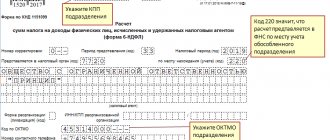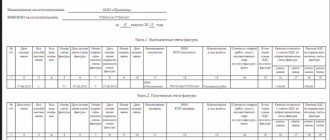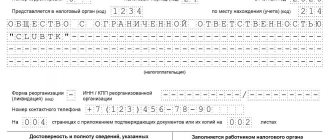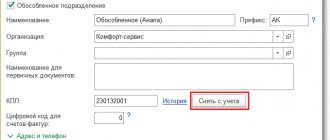A company whose structure includes one or more separate branches is required to calculate income tax according to special rules that differ from enterprises that do not have separate divisions. The fact is that such a company receives profit jointly, i.e. formed from the general activities of all divisions, therefore it is necessary to declare its volume in tax reporting, having previously distributed it among operating structures.
According to the general rules, such enterprises need to report to the Federal Tax Service on income tax (PIT) not only at the place of registration of the parent company (GC), but also at the location of its separate divisions (SP) (clause 1 of Article 289 of the Tax Code of the Russian Federation). Let us recall the criteria for forming a declaration on non-commercial tax in force today.
When is a separate division's income tax return submitted?
According to the requirements of legislators, the obligation to transfer ENP or tax advances to the federal budget (FB) remains exclusively with the parent enterprise and is carried out at the place of its registration (clause 1 of Article 288 of the Tax Code of the Russian Federation).
As for the transfer of taxes to regional budgets, the law does not prohibit the use of several scenarios. Thus, both the Civil Code and the OP can transfer NNP to the BR in full if they are located in the same region. If the parent company has secured the option of settlements with the Federal Tax Service on its own behalf, without involving the OP and splitting profits, then it reports, and there is no need to submit a tax return for the profit tax of the branch at the place of its registration.
When carrying out activities on the territory of one subject of the Russian Federation by several branches, tax can also be paid to the regional budget at the location of one of them (responsible OP). In such a situation, only one declaration is submitted - from the OP responsible for the centralized transfer of tax.
But branches located in different regions, as a rule, declare profits each for themselves, reporting to their territorial inspection. And here it is necessary to correctly calculate the amount of profit from which the branch contributes NNP to the regional budget.
Completing the fifth application
Appendix No. 5 of the income tax declaration of a separate division is filled out in the following order:
- Line 030 reflects information from the second sheet, line 120.
- Line 040 indicates the share of the branch's profit.
- Line 050 is intended to indicate the product of data from application lines 030 and 040.
- Line 060 indicates the rate at which tax is paid to the regional budget.
- Line 070 contains the product of the data from lines 050 and 060 of application number five.
- Line 080 is filled in as follows:
- If the company pays both quarterly and monthly advances - the amounts of data from application lines 120 and 070;
- If the company pays only quarterly prepayments, the information from line 070 of the application for the previous period is copied into this line.
- Line 100 indicates the difference obtained between lines 070 and 080. If the result obtained is less than or equal to zero, a dash is entered.
- In line 110, write down the difference obtained between lines 080 and 070. If the final number turns out to be less than or equal to zero, make a dash.
- Line 120 is filled in like this:
- If the organization pays both quarterly and monthly advances - the product of line 310 from the second sheet and line 040 from the application;
- If the company pays only quarterly prepayments, a dash is added.
- Filling out line 121 is done as follows:
- If the company pays both quarterly and monthly prepayments, the information from line 120 of application number five is rewritten;
- If the organization pays only quarterly advances, a dash is added.
Similar articles
- Calculation of profit for a separate division
- Unified calculation of insurance premiums in 2021 (example)
- Line 290 of the income tax return
- How to fill out 6-NDFL correctly
- Income tax return 2018
Features of profit distribution
The principles for calculating and paying non-taxable income by a multi-branch payer are regulated by Article 288 of the Tax Code of the Russian Federation. The tax amounts are determined based on the base, i.e., the share of profit due to the “separateness” and the tax rate established by local laws.
The share of the branch's profit is determined as the arithmetic average of the sum of the share of the average number of personnel or labor costs and the residual value of fixed assets and intangible assets of the branch. Like any of the above tax payment options, the calculation of the average profit volume for an OP must be enshrined in the company’s local regulations and agreed upon with the Federal Tax Service.
Example
The amount of taxable profit for having one OP, in general, for 9 months of 2021 amounted to 6,800,000 rubles. Let’s assume that the enterprise has established the procedure for submitting a declaration on non-compliance with both the parent company and the OP. The frequency of submitting company reports to the Federal Tax Service is quarterly. The NNP rate is 20% (3% to the federal budget, 17% to the regional budget).
Indicators for calculating the share of taxable profit for the reporting period:
| Index | Overall for the company | Incl. according to OP | Estimated value |
| Average headcount | 80 people | 30 people | 30 / 80 x 100 = 37.5% |
| Residual value of assets | 12,000,000 rub. | 6,000,000 rub. | 6000000/12000000 x 100 = 50% |
| The arithmetic mean, which determines the share of profit in the OP | (37,5% + 50%) / 2 = 43,75% | ||
The share of profit for payment to the regional budget for the OP is 2,975,000 rubles. (6800000 x 43.75%)
The amount of OP tax payable to the regional budget is RUB 505,750. (2975000 x 17%)
Thus, in the tax return declaration, the company’s branch will reflect the amount of accrued tax to the regional budget in the amount of 505,750 rubles, and the parent company will indicate the following transfers:
- to the federal budget - 204,000 rubles. (6800000 x 3%);
- to the regional budget - 650,250 rubles. (6800000 x 17% – 505750)
Essence of the question
Participation in the main type of income-generating activity obliges you to pay income tax in separate divisions. Consequently, proper distribution of tax burden between branches plays a very important role.
For separate structures, the income tax rate is similar to the rate for independent companies. The amount of tax burden is regulated in Article 288 of the Tax Code of the Russian Federation and is equal to 20% of the amount of profit received. Let us remember that it is not the amount of revenue received that is subject to taxation, but only the difference between income and production costs.
Tax payments are distributed among budgets:
- 17% should be transferred to the regional budget;
- and only 3% go to the federal one.
Payment to the federal budget (3%) is credited without distribution. It is carried out by the parent agency. But 17% of the regional budget goes to the distribution of income tax between separate divisions, depending on the location of the separate and main branches.
IMPORTANT!
If the main office and a separate division are located in the same region, there is no need to distribute income taxes. Any of the structural divisions of a legal entity is allowed to pay budgets, but it will be necessary to notify the Federal Tax Service about this method of payment. This must be done before the end of the year preceding the transition to the new payment method.
Income tax declaration of a separate division: nuances of formation
The composition of the declaration on the non-regulatory tax of the head office of a multi-branch company is a standard package (common for all enterprises), supplemented by Appendix No. 5 to sheet 02, compiled for each separate structure.
A branch paying NPT to the regional budget is required to submit a declaration that contains:
- Title;
- Subsection 1.1 to section 1 (for quarterly reporting);
- Subsection 1.2 to section 1 (for monthly payments);
- Appendix No. 5 to sheet 02 (Ex.5 L02).
The procedure for filling out a declaration for the company as a whole
The profit declaration for a separate division is filled out as follows:
- The report includes applications number five, completed for each branch and for the entire company as a whole, excluding branches.
- On the second sheet, dashes are added in lines 140 and 160.
- On the same sheet, line 200 indicates the sum of indicators from line 070 of all applications under number five. In this regard, the second sheet can be completely filled out only after the application has been completed.
- In the first section, in subsections 1.1. and 1.2. information is recorded only about those advance payments to the regional budget that must be paid at the location of the branch. This data is taken from the head office application, in particular:
- In lines 070 and 080 of subsection 1.1. information is transferred from appendix lines 100 and 110;
- In lines 220 to 240, one third of the value is indicated, which is indicated in the application, in line 120.
Procedure and criteria for filling out the OP declaration
Let us recall some of the nuances of preparing a branch income tax return. The declaration and the procedure for filling it out in 2021 approved. by order of the Federal Tax Service dated October 19, 2016 No. ММВ-7-3/572 (from the report for 2021, a new form will be in effect - order of the Federal Tax Service dated September 23, 2019 No. ММВ-7-3/475). The title states:
- TIN of the company, checkpoint of the branch;
- reporting period code (in our example, “33” means half a year);
- code of the territorial Federal Tax Service where the report is submitted;
- code at the place of registration of the OP – “220” (at the location of the OP);
- the name of the “isolation”.
How is profit share determined?
Calculation of income tax for separate divisions requires the use of the following indicators:
- Residual value of property taking into account depreciation;
- Average salary costs.
Only one of the indicators can be used. But before application, it must be approved in the company's accounting policies. It cannot be changed until the end of the reporting year. So says the article. 313 Tax Code of the Russian Federation.
For example, if a company decides to be guided by the average wage indicator, then a simple formula is applied: the percentage of the total number of employees divided by the number of employees in the EP and multiplied by 100%. The basis for determining the average number of employees is the following documents from the HR department.
- Orders and instructions from management - to reflect the facts of hiring, dismissal, transfer to another place, and granting leave;
- Payroll statements;
- Personal cards of employees;
- A time sheet in which it is customary for an organization to indicate important labor indicators, such as the amount of working time and the procedure for remuneration.
Such documents will help to obtain the most accurate data for each working day and employee. The places of implementation of labor relations are fixed in the employment contract. The preparation of financial documentation is also subject to these requirements. If a separate division is closed, income tax becomes the responsibility of the parent enterprise or another division.
Similar articles
- How to create a separate division of an LLC?
- 6 Personal income tax for separate divisions
- Calculation of profit for a separate division
- Profit declaration for a separate division: example
- Calculation of transport tax (accounting entries)
Profit declaration in the presence of OP
Thanks for the clarification. As far as I understand, running an organization with separate divisions is also not provided for here. In this case, the distribution of profits between OPs will have to be done manually. To answer the question, I can only briefly give a diagram. At the seminar on October 20, 2020 on Reporting for 9 months Income Tax Declaration, this issue will be discussed in more detail [10/20/2020 broadcast] Income Tax Declaration and Property Taxes for 9 months of 2020 in 1C. 1 Step. Close the period (determine the tax base for income tax). Step 2: Determine the share of profit for each OP. The distribution is made according to the specific weights of: - one of the labor indicators - the average list. headcount (SSCh) or labor costs (Exp. OT) for the period, in our case for 9 months. The selected labor indicator must be fixed in the UE for NU purposes. — average annual residual value of depreciation. property (NU)(Am.). Formula for calculating the residual value of depreciation. property for 9 months - the same as for calculating the average annual cost for property tax, only the base includes all property recognized as depreciable in the NU, incl. Intangible assets and not subject to depreciation in accordance with clause 2 of Art. 256 Tax Code of the Russian Federation. Thus, the share of profit is found according to the formula: Share of profit. OP = (SSCh OP/SSCh Total*100% + Am.Im. OP/Am.Im.Total * 100%)/2 or Share of profit. OP = (Exp. FROM OP/Exp. FROM Total*100% + Am.Im. OP/Am.Im.Total * 100%)/2 After determining the share of OP, you can begin filling out declarations. 3 Step. To fill out declarations in the database for all OPs, it is necessary to establish for the organization all registrations with the tax authorities for all OPs. This can be done in the organization’s card using the link Registration with the tax authorities. In the registration form, set: - Checkpoint of a separate division - Tax authority code, Fill in by code button - OKTMO Step 4. Consistently create tax returns for the head unit and for each OP separately, selecting the appropriate tax authority code on the title page. 5 Step. For GPs in the declaration, create as many sheets of Appendix No. 5 as OP + GP. On page 040 of Appendix No. 5 to Sheet 02, manually set the appropriate share of the OP’s profit on page 060 - the tax rate established by the region, if the OP’s rate differs from the general one. In general - 17%. on page 080 - the amount of accrued advance payments for the six months for this OP. The rest - if any. The dark green fields will be filled in automatically. For GPs, the composition of the declaration is for the entire organization + Appendix No. 5 for all EPs. 6 Step. For each OP, create your own declaration consisting of: - Title page - Section 1 - Appendix No. 5 to Sheet 02 Appendix No. 5 is filled out in the same way as stated above. Here's a brief summary of how to fill out a declaration with the OP. If you have any questions, ask.






